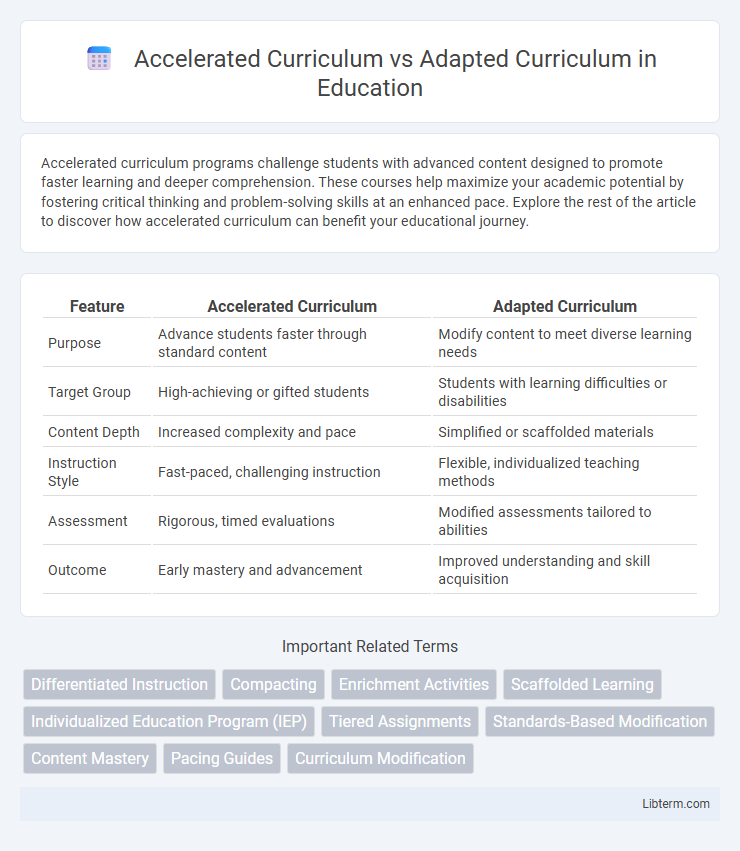Accelerated curriculum programs challenge students with advanced content designed to promote faster learning and deeper comprehension. These courses help maximize your academic potential by fostering critical thinking and problem-solving skills at an enhanced pace. Explore the rest of the article to discover how accelerated curriculum can benefit your educational journey.
Table of Comparison
| Feature | Accelerated Curriculum | Adapted Curriculum |
|---|---|---|
| Purpose | Advance students faster through standard content | Modify content to meet diverse learning needs |
| Target Group | High-achieving or gifted students | Students with learning difficulties or disabilities |
| Content Depth | Increased complexity and pace | Simplified or scaffolded materials |
| Instruction Style | Fast-paced, challenging instruction | Flexible, individualized teaching methods |
| Assessment | Rigorous, timed evaluations | Modified assessments tailored to abilities |
| Outcome | Early mastery and advancement | Improved understanding and skill acquisition |
Understanding Accelerated Curriculum
Accelerated curriculum emphasizes advanced learning and faster pace, designed to challenge high-achieving students by covering grade-level content in less time or introducing higher-level material earlier. It prioritizes depth and complexity, ensuring learners develop critical thinking and problem-solving skills through enriched academic experiences. This approach contrasts with adapted curriculum, which modifies content to accommodate diverse learning needs without necessarily speeding up the instructional process.
Defining Adapted Curriculum
Adapted curriculum refers to a personalized educational plan tailored to meet the unique learning needs, abilities, and interests of individual students, often including modifications in content, process, and assessment methods. It aims to provide appropriate challenges and support for diverse learners, including those with disabilities or learning difficulties. By focusing on differentiating instruction rather than accelerating content, adapted curricula promote inclusive education and equitable access to learning opportunities.
Key Differences Between Accelerated and Adapted Curricula
Accelerated curriculum compresses standard content into a shorter time frame to challenge advanced learners, emphasizing pace and depth of knowledge. Adapted curriculum modifies content complexity, delivery, and assessment to meet diverse learning needs, focusing on accessibility and individualized support. Key differences lie in acceleration aiming for faster progression, while adaptation targets personalized learning adjustments to optimize student success.
Benefits of Accelerated Curriculum
Accelerated curriculum enhances student learning by allowing advanced learners to progress through material at a faster pace, promoting deeper engagement and mastery of subjects. This approach supports academic achievement by challenging students with higher-level content, leading to improved critical thinking and problem-solving skills. Schools implementing accelerated programs often observe increased motivation and higher standardized test scores among participants compared to peers in adapted curriculums.
Advantages of Adapted Curriculum
Adapted Curriculum offers personalized learning pathways that cater to individual student needs, enhancing engagement and comprehension for diverse learning styles. It supports flexible pacing and differentiated instruction, enabling students with varied abilities to achieve mastery without the pressure of accelerated timelines. This approach fosters inclusive education by accommodating special education requirements and promoting a supportive learning environment.
Challenges of Implementing Accelerated Programs
Implementing accelerated curriculum programs often faces challenges such as addressing diverse learner readiness levels and ensuring sufficient support for advanced students without neglecting others. Schools must manage resource allocation effectively, including trained instructors and tailored materials to meet the demands of a faster-paced learning environment. Resistance from stakeholders concerned about increased pressure and potential social-emotional impacts on students can further complicate program adoption and success.
Addressing Diverse Learning Needs With Adapted Curriculum
The adapted curriculum is designed to meet diverse learning needs by tailoring instructional content, pace, and assessment methods to individual student abilities and interests. It allows educators to modify materials and teaching strategies to support students with learning disabilities, English language learners, and those requiring different levels of challenge. This personalized approach fosters inclusivity and maximizes each student's potential by addressing their unique educational requirements.
Student Suitability: Who Benefits Most?
Accelerated curriculum suits high-achieving students who grasp concepts quickly and benefit from a faster pace, challenging them beyond grade-level expectations. Adapted curriculum best supports students with diverse learning needs or slower processing speeds by modifying content and delivery to match individual abilities. Both approaches optimize educational outcomes by targeting student readiness and learning styles for maximum engagement and growth.
Choosing the Right Approach for Your Educational Setting
Selecting between an accelerated curriculum and an adapted curriculum depends on the educational goals and student needs within your setting. Accelerated curriculum is designed to challenge advanced learners by increasing the pace and complexity of content, ideal for environments prioritizing academic rigor and rapid progression. In contrast, an adapted curriculum modifies content and delivery to accommodate diverse learner abilities, fostering inclusivity and supporting students with varying skill levels or learning differences.
Future Trends in Curriculum Design
Future trends in curriculum design emphasize personalized learning pathways, with accelerated curricula enabling advanced learners to progress through content at an increased pace, while adapted curricula provide tailored modifications to meet diverse student needs. Integration of technology and AI-driven analytics supports real-time assessment and customized instruction, enhancing both acceleration and adaptation strategies. Emerging educational models prioritize flexibility and inclusivity, ensuring curricula evolve to accommodate varying learner profiles and future workforce demands.
Accelerated Curriculum Infographic

 libterm.com
libterm.com